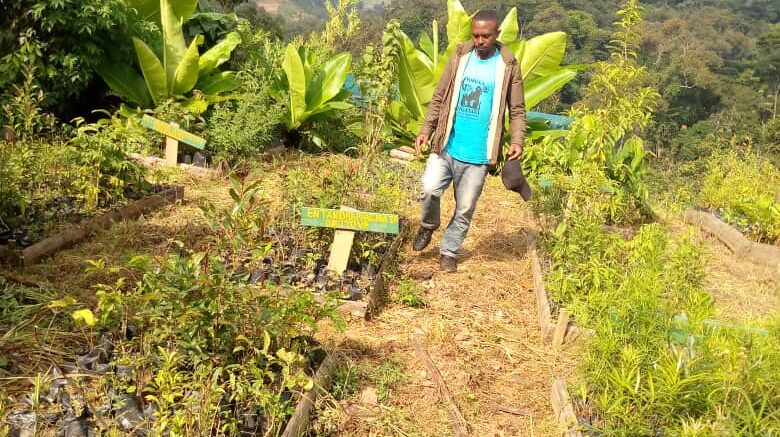Approach 4: Increasing Tree cover in Public Lands and Spaces
Increasing tree cover in public lands and spaces through Assisted Natural Regeneration (ANR) techniques and tree planting around Bwindi National Park, Lake Mutanda, and Lake Mulehe in the Kisoro District involves a combination of strategic planning, community involvement, and environmental restoration practices.
1. Site Assessment and Planning:
- Identify Target Areas:
Conduct a thorough assessment to identify specific public lands and spaces that require increased tree cover. Focus on areas around Bwindi National Park, Lake Mutanda, and Lake Mulehe.
- Analyze Soil and Environmental Conditions:
Assess soil quality, topography, and other environmental conditions to determine the most suitable tree species for each location. This ensures that the selected trees are well-adapted to the local ecosystem.
- Mapping and Zoning:
Create maps and zoning plans to designate areas for ANR and tree planting. Consider factors such as biodiversity, water sources, and existing vegetation cover to guide the distribution of restoration efforts.
2. Community Engagement and Participation:
- Community Consultations:
Engage with local communities surrounding Bwindi National Park, Lake Mutanda, and Lake Mulehe to seek their input and involvement. Understand their perspectives, traditional knowledge, and priorities related to environmental conservation.
- Community Workshops:
Conduct workshops to raise awareness about the importance of increasing tree cover and the specific benefits for the community. Explain the chosen restoration techniques and encourage active participation.
- Formation of Community Restoration Teams:
Facilitate the formation of community-based restoration teams or committees. These teams can play a crucial role in planning, implementing, and monitoring restoration activities.
3. Assisted Natural Regeneration (ANR):
- Identify Native Species for ANR:
Identify native tree and plant species suitable for ANR. These should be species that naturally regenerate in the area and contribute to the restoration of the ecosystem.
- Protection Measures:
Implement protection measures for existing vegetation to encourage natural regeneration. This may involve installing fencing, signage, or community patrols to prevent grazing or other activities that could harm regenerating plants.
- Monitoring and Management:
Establish a monitoring system to track the progress of ANR. Regularly assess the health and growth of naturally regenerating vegetation, and implement management practices as needed.
4. Tree Planting Initiatives:
- Selecting Tree Species:
Choose tree species that are suitable for afforestation efforts. Consider the ecological requirements of each species, their role in supporting biodiversity, and their potential benefits to the community.
- Community Tree Planting Events:
Organize community tree planting events in designated areas. Encourage participation from community members, schools, and local organizations to maximize the number of trees planted.
- Seasonal Planning:
Plan tree planting activities according to the most suitable seasons for the selected tree species. This ensures optimal survival rates and growth.
5. Water Source Protection:
- Riparian Buffer Zones:
Establish riparian buffer zones around water sources like Lake Mutanda and Lake Mulehe. These buffer zones help prevent soil erosion, filter pollutants, and protect water quality.
- Vegetative Cover:
Increase vegetative cover around water sources to stabilize soil and reduce runoff. This can be achieved through a combination of ANR and targeted tree planting initiatives.
6. Stakeholder Collaboration:
- Government and NGO Partnerships:
Collaborate with government agencies, non-governmental organizations (NGOs), and other stakeholders involved in environmental conservation. Leverage their expertise, resources, and support to enhance the impact of restoration efforts.
- Educational Institutions:
Partner with local schools and educational institutions to involve students in tree planting activities and environmental education programs. This fosters a sense of environmental stewardship from an early age.
7. Monitoring and Evaluation:
- Establish Monitoring Protocols:
Develop clear protocols for monitoring the success of ANR and tree planting initiatives. Include parameters such as survival rates, growth rates, and changes in biodiversity.
- Regular Assessments:
Conduct regular assessments to evaluate the effectiveness of restoration activities. Adjust strategies based on feedback and lessons learned to improve future interventions.
8. Communication and Awareness:
- Communication Campaigns:
Implement communication campaigns to inform the broader community about the ongoing restoration efforts, their significance, and how individuals can contribute.
- Showcasing Success Stories:
Share success stories and positive outcomes from the restoration initiatives to inspire and motivate community members. Use various media channels, including social media, to amplify the message.
